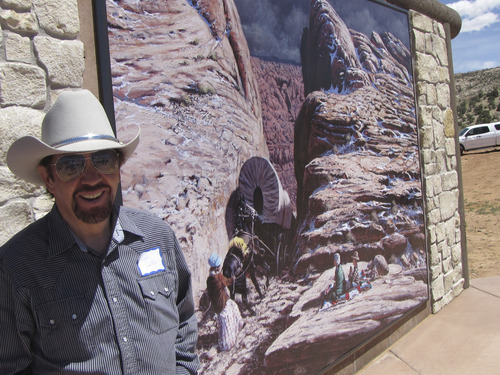This is an archived article that was published on sltrib.com in 2011, and information in the article may be outdated. It is provided only for personal research purposes and may not be reprinted.
Escalante • About 300 people gathered in Escalante on Saturday to pay tribute to the intrepid early settlers who, on a mission to settle southeastern Utah, carved a trail down a near-vertical cliff to move wagons, livestock and supplies.
The audience listened to music and heard speeches and accolades as part of the dedication of the first phase of The Hole in the Rock Escalante Heritage Center, which has been planned for more than 20 years.
The outdoor plaza contains information and two large murals depicting the struggles of a band of Mormon settlers who spent six months in 1879 and 1880 chiseling, digging and blasting a crude, steep road down a cliff to the banks of the Colorado River. That road became known as Hole in the Rock.
The site, more than 50 miles south of Escalante on Hole in the Rock Road, is growing in popularity as a famous testament to the struggles of Western settlement. It is also integral to the history of Garfield and Kane counties, where some descendants of the original pioneers still live.
Pioneers in southern Utah's Cedar City, Parowan and St. George were asked in 1878 by LDS Church President John Taylor to settle what is today San Juan County.
The Heritage Center plaza, built with $650,000 donated by the Utah Department of Transportation and $100,000 from the Mormon Pioneer National Heritage Association, tells a brief history of the difficulties endured by the pioneers.
Alan Smith pointed to a baby being held in one of the murals — a weather-resistant reproduction of a painting by Escalante artist Lynn Griffin — and said it depicts his grandfather, Roy Smith.
Lt. Gov. Greg Bell, whose ancestors helped settle Bluff in San Juan County, told those gathered under sunny skies Saturday as an eagle soared overhead that the Hole in the Rock settlers were a "hardscrabble" people who represent the heritage of the land.
He said much of southern Utah, instead of being liberal or conservative, is inhabited by "communitarians" as exemplified by the cooperative and persistent efforts that resulted in the completion of the Heritage Center.
"You do things together," Bell said. "This [center] wasn't built with money donated by one family. It's a beautiful heritage and one you should always honor and be proud of."
Steven Snow, a member of the Presidency of the Seventy of The Church of Jesus Christ of Latter-day Saints, told the audience that ever since he went to a similar dedication as a child in Pine Valley in Washington County, he developed a respect for the great meaning behind dedications like Saturday's event.
"What went before us is inspiring," said Stevens, who visited the Hole in the Rock site for the first time Friday.
The LDS Church donated the 9.5 acres of land on which the center will be built. A more ambitious museum building is to be built in phase two at an expected cost of $2 million, funded by donations.
One of the reasons for the growing popularity of the site is the 2009 publication of Undaunted: The Miracle of the Hole in the Rock Pioneers by Gerald Lund, who attended Saturday's ceremony.
In an interview, Lund said he knew little of Hole in the Rock until 1996, when a local historian took him to the site and explained the settlers' arduous accomplishment.
"Over and over when I realized what they did it just blew me away," said Lund. "I found myself saying, they took wagons and did what? I knew someday I had to write the story."
The growing popularity of the site also has the Bureau of Land Management and Glen Canyon National Recreation Area, agencies on whose land the present road crosses, conducting an environmental assessment on increasing the number of people in organized groups allowed to visit the site beyond the current 25.
An open house discussing the assessment is scheduled for 4-7 p.m. Wednesday at the Escalante Interagency Visitor Center. Comments on the assessment will be taken until June 17 at utgsecmt@blm.gov. (Include "Hole-in-the-Rock Group Use" in the subject line.)
mhavnes@sltrib.com Hole in the Rock Escalante Heritage Center
Donations • Those wanting to donate to the center's second phase can go online to escalanteheritagecenter.org.
Open house • A public review open house has been scheduled for 4-7 p.m. Wednesday at the Escalante Interagency Visitor Center for the Hole-in-the-Rock Road-Organized Group Use Environmental Assessment.
Environmental assessment • The environmental assessment for group use along Hole in the Rock Road can be downloaded from on.doi.gov/kxybq7. Hard copies are also available at all Grand Staircase-Escalante National Monument offices and visitor centers.
Submitting comments • Send comments by June 17 to utgsecmt@blm.gov (Include "Hole-in-the-Rock Group Use" in the subject line.) Or send a letter to:
Bureau of Land Management
Grand Staircase-Escalante National Monument
Attn: Jabe Beal, Outdoor Recreation Planner
755 West Main Street / PO Box 225
Escalante, UT 84726





